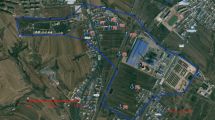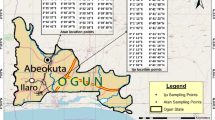Abstract
Site characterization was performed on an area of 580 km2 around the strategically vital freshwater aquifers of the Al-Rawdhatain and Umm Al-Aish to assess the status of groundwater pollution as the result of Iraq invasion to Kuwait in 1991. Advanced data analysis and visualization software (EVS-Pro) was used for groundwater contamination assessment analytes: total petroleum hydrocarbon (TPH) and total dissolved solids (TDS). This will reduce the number of samples needed (saves time and money) and provide a superior assessment of the analytes distribution. Based on the “minimum–maximum plume technology” analysis, the nominal plume area with a threshold of 0.031 mg/kg TPH is estimated at about 0.47 km2. This is the difference between the maximum and minimum predicted plume sizes. EVS-Pro also computed 3.3775 × 109 and 4.0788 × 106 for the plume volumes and masses (dollars per volume and mass), respectively. Also, new sampling locations were determined for further detailed site assessments based on the confidence and uncertainty analysis, which is more defensible and cost-optimized approach. This will reduce the number of samples needed (saves time and money) and provide a superior assessment of the analytes distribution. These tools prove to be effective in assessing remediation costs of clean-up versus benefits obtained and in developing a cost-effective monitoring programme for insights into processes controlling subsurface contaminant transport that impact water quality.










Similar content being viewed by others
References
Bou-Rabee FA (1996) The tectonic and depositional history of Kuwait from seismic reflection data. J Pet Geol 19:183–198
C Tech Development Corporation (2013) http://www.ctech.com/. Accessed 13 Mar 2016
Fadlelmawla A, Hadi K, Zouari K, Kulkarni K (2008) Hydrogeochemical investigation of recharge and subsequent salinization processes at Al-Rawdhatain depression in Kuwait. Hydrol Sci 53(1):204–223
KISR (2009) Long-term monitoring and remediation strategy for hydrocarbon pollutants in the groundwater of Al-Rawdhatain and Umm Al-Aish fields (vol 1). WM016C. Hydrology Department Water Resources Division, Kuwait Institute for Scientific Research
KISR (2013) Interim report of deliverable Tms 4.1.9. Results of the 1st year groundwater quality monitoring. The first four rounds of groundwater surveillance monitoring management support and technical supervision of Kuwait environmental remediation program for Kuwait National Focal Point (Sp006c) Kuwait Institute for Scientific Research, PO. Box 24885, 13109—Kuwait
Kwarteng AY, Viswanathan MN, Al-Senafy MN, Rashid T (2000) Formation of fresh groundwater lenses in Northern Kuwait. J Arid Environ 46(2):137–155
Mukhopadhyay A, Al-Sulaimia J, Al-Awadi E, Al-Ruwaih F (1996) An overview of the Tertiary geology and hydrogeology of the northern part of the Arabian Gulf region with special reference to Kuwait. Earth Sci Rev 40(3–4):259–295
Mukhopadhyay A, Rashid T, Al-Haddad A (2006) Technical assistance to the monitoring and assessment of the environmental damage to the groundwater resources of Kuwait, Progress Report No. 3. Kuwait Institute for Scientific Research, Report No.: KISR8054, Kuwait
Omar SA, Al-Yacoubi A, Senay Y (1981) Geology and groundwater hydrology of the State of Kuwait. J Arab Gulf Arab Penins Stud 1:5–67
Otaibi M, Mukhopadhyay A (2005) Options for managing water resources in Kuwait. Arab J Sci Eng 30(2C):55–68
Robinson BW, Al-Ruwaih F (1985) The stable isotopic composition of water and sulfate for the Rawdhatain and Umm Al-Aish fresh water fields, Kuwait. Chem Geol 58:129–136
Sadiq M, McCain JC (1993) The Gulf War aftermath—an environmental tragedy. Kluwer Academic Publishers, Berlin, p 84
SMEC (2006) GD 5.12—“groundwater damages and remediation of the Rawdhatain and Umm Al-Aish freshwater aquifers of Kuwait”. Program for the monitoring and assessment of the environmental consequences of the Iraqi aggression in Kuwait
SMEC (2014) Groundwater modelling of the Rawdhatain and Umm Al-Aish freshwater aquifers of Kuwait
Somaratne N, Zulfic H, Ashman G, Vial H, Swaffer B, Frizenschaf J (2013) Groundwater risk assessment model (GRAM): groundwater risk assessment model for wellfield protection. Water 5:1419–1439
Acknowledgments
The authors would like to thank the Kuwait National Focal Point for Environmental Projects, Ministry of Electricity and Water in Kuwait—Groundwater Sector and SMEC international for providing access to some of their data.
Author information
Authors and Affiliations
Corresponding author
Rights and permissions
About this article
Cite this article
Yihdego, Y., Al-Weshah, R.A. Gulf war contamination assessment for optimal monitoring and remediation cost-benefit analysis, Kuwait. Environ Earth Sci 75, 1234 (2016). https://doi.org/10.1007/s12665-016-6025-3
Received:
Accepted:
Published:
DOI: https://doi.org/10.1007/s12665-016-6025-3




